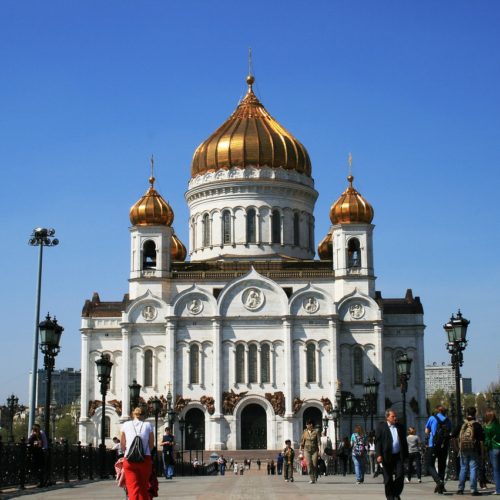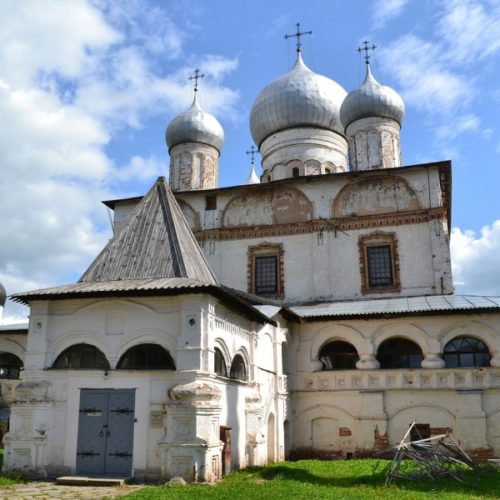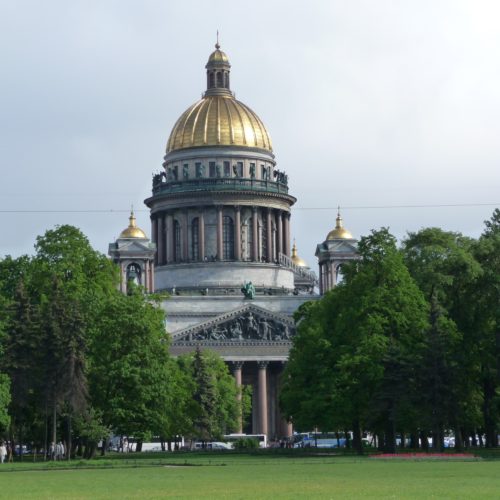SAMPLE ITINERARIES | EXCURSIONS IN ST. PETERSBURG | EXCURSIONS IN MOSCOW
City tour:
Moscow Sightseeing Tour will help you get acquainted with Moscow, the capital of Russia. You will receive interesting information on the history of this old city as the origin of Moscow has been a mystery for a long time, and there are countless stories and legends about Moscow. You will have an opportunity to see unique historic, architectural, and cultural landmarks: the Kremlin, St. Basil the Blessed Church, the Bolshoi Theatre, and Cathedral of Christ the Saviour. You get an understanding of modern Moscow – centre of political, financial, cultural, and spiritual life of Russia.
St. Basil’s Cathedral:
The Red Square has always been the main square of Moscow. During major religious holidays processions went from the Kremlin to the Red Square, and the square was full of people on these days looking like an open-air church. It was here that the magnificent cathedrals were built. One of them is St. Basil the Blessed Church. The cathedral was built in the middle of the XVI century during the reign of Ivan the Terrible. In 1558, a small chapel was attached to the church. Basil the Blessed was buried here. Since then the cathedral became known as St. Basil the Blessed Church
The Kremlin:
The Kremlin is the historic centre, the heart of Moscow. It is one of the most renowned museums of the world that attract large numbers of visitors. The Kremlin is situated on a hill washed on one side by the Moscow River. In the territory of the Kremlin you can see the Tsar Bell and the Tsar Cannon, and visit the Annunciation Cathedral, the Archangel Cathedral, and the Cathedral of the Ascension, the Bell Tower of Ivan the Great, and Church of the Twelve Apostles, that are magnificent monuments of Russian church architecture with unique interiors.
Armoury:
The world known Armoury Chamber in Moscow is one of the first Russian museums. The museum houses the collection of Russian, Oriental, and Western pieces of art dated V-XX centuries, thrones of Russian Tsars, clothes and armour, and unique silver and golden dishes. You will have an opportunity to see the regalia of Grand Dukes and Tsars, carriages, and the collection of armours. You will listen to remarkable stories about its former owners. The Armoury Chamber as a depository of Tsars’ treasures was first mentioned in the chronicles in the beginning of the XVI century. Presently the museum’s collection includes over 4000 exponents.
Diamond Collection:
The collection of diamonds in Moscow is one of the largest collections of gem stones in the world. The crown jewels of the collection are the historic relics such as state regalia and rear precious stones. This collection is comprised of royal treasures that were previously kept in the Winter Palace in St. Petersburg. This collection is of great cultural and historical value. Here you can see the most massive imperial crown decorated with 5 thousand diamonds, most valuable Russia awards, and platinum and gold nuggets. Priceless treasures of the Diamond Fund are a part of national wealth of the country.
New Maiden Convent:
It is one of the most famous historic landmarks of Moscow built in the XVI century. It is a functioning convent of the Russian Orthodox church. The convent was built in the end of the XVII century and since the time of its construction till now the convent remains one of the best architectural ensembles of Russia. It used to be the wealthiest convent in Moscow. The territory of the Novo-Devichiy convent is also a burial ground. The Novo-Devichiy cemetery is divided into two parts: “old” and “new”. The “old” cemetery is located right on the territory of the convent and is a place of burial of such people as daughter of Ivan the Terrible, sisters of Peter the Great, heroes of the Patriotic War of 1812, famous writers, philosophers, and poets. The “new” cemetery was established between 1898 and 1904. It lies to the South from the convent. The territory of the cemetery was extended during the Soviet years when the Novo-Devechiy convent became the second most honorary place of burial in the country after the Kremlin wall. Among those buried in the territory of the new cemetery were Chekhov, Gogol, Bulgakov, Stalin’s wife and Nikita Khrushchev.
State Tretiakov Gallery:
The Tretyakov Gallery in Moscow is the national repository of Russian art and is one of the largest museums in the world. It was established in 1856 and is named after its founder Pavel Tretyakov who donated a part of his collection to Moscow, in 1892. The main building of the museum is situated not far from the Kremlin. The collection includes approximately 125 000 pieces of art. Among them are unique works of Old Russian art including the eminent icons by Andrey Rublev, Semen Ushakov, and others. Works of the XIII-XIX centuries are kept here.
Pushkin Fine Art Museum:
The Pushkin museum in Moscow is one of the major arts museums in Russia. It is located in the centre of Moscow, not far from the Kremlin, opposite of the Cathedral of Christ the Saviour. The collection consists of over half a million pieces of art from different times. Among them there is a unique collection of Antique, Medieval, and Renaissance sculptures. The museum collection contains works by great artists from Italy, Holland, Spain, England, France, and Germany. The world famous collection of French paintings of the XIX-XX centuries that includes major works of Monet, Reno, Van Gog, and Picasso is presented here.
Arbat Street:
The famous Moscow subway is a symbol of constructivism and is decorated with chandeliers and tons of marble. Most of its stations were designed as monuments of architecture. The length of underground railroads exceeds 250km. There are over 160 subway stations in Moscow, and new ones are constantly being built. Entrances to the subway stations that are the most beautiful in the world were built approximately fifteen years ago; in 1935 the first subway railroad line was launched. Old Arbat is a street full of people day and night. Arbat is a paved pedestrian street and is one of the most popular places for dates and walks in Moscow. It is here that artists, musicians, lovers of poetry and song writers meet.
Kolomenskoe:
Kolomenskoye is the former residence of Moscow Grand Dukes and Tsars located on the high right bank of the Moscow River. Today it is a museum, a memorial of Russian architecture of XVI-XVII centuries. Over 20 architectural monuments were preserved in Kolomenskoye, among which is the XVI century church. Kolomenskoye museum exhibits numerous unique pieces of wooden architecture. One of them is the house of Peter the Great.
Sergiev Posad:
Sergiev Posad is the Russian Orthodox church centre. Moscow during all its history was developing not only as the main administrative centre, but also as the centre of Russian religious life. This is the topic of this excursion. You will visit chapels, churches, cathedrals, and monasteries of Moscow. You will visit the Trinity Monastery of St. Sergiy (Lavra) founded by Sergiy Radonezhsky (1314-1392) in 1340. You will visit the Sacrarium were the treasures of Lavra are kept: unique paintings, clerical clothes, and books. You will have an opportunity to see the elegant XV-XVII centuries’ churches and the Clerical Academy.
Kuskovo:
Kuskovo is a magnificent XVIII century’s palace and a park that used to belong to the Sheremetievs family. The main building of the ensemble the Kuskovo Palace was built of the bank of a large water pond. This is the architectural focus of the whole ensemble of the large inner yard that includes the church, kitchens and bell tower with a spire. There is also a grotto in the park that looks like an underwater cave – the Kingdom of Neptune. In 1918, the Kuskovo residence was granted the statues of a museum. And in 1932, the museum of china was established here. It has a very large collection of Russian, Chinese, German, English, French and Danish porcelain and faience, lusterware and glass.
Abramtsevo:
Here in Abramtsevo village near Moscow the modest beauty of Russian nature becomes unusually visible. Abramtsevo is one of the few museums that preserve the charm of the old times. Here, in the park, one can find Aksakov’s house, Church of Christ the Saviour, and wooden constructions in neo-Russian style: Teremok, art studios, and a Hut on the Chicken Legs for kids built by Vasnetsov based on Russian folklore. In all these buildings there are multiple unique items of mundane life of Russian people of the XVIII-XX centuries. Among the exponents there are works of famous Russian artists together with kitchen-ware, spinning wheels, dolls, and other objects created by folk craftsman. Abramtsevo memorial complex is more than just a collection of exponents. It is a place where artistic life continues up to the present days. It is also a place for those who would like to feel the charm of the measured life of Russian nobility of the XIX century.
Yuri Gagarin Training Centre (Star city)
An excursion to the all-Russia famous Cosmonaut Training Centre named after Yuri Gagarin who was the first cosmonaut on a piloted flight in space. The centre has a memorial museum and cabinet of Yuri Gagarin. During the excursion you will have an opportunity to visit the special technological area of the centre where unique simulators, centrifuges, and hydro-laboratory with modules of spacecrafts are located. A model of the space station lies in a huge swimming pool (diameter 23m, depth 19m). Water allows cosmonauts to experience zero-gravity and to acquire skills necessary for their flights to space. The aero-navigation stand designed in the planetarium provides an opportunity to study the starry heavens.
Monino:
It presents a collection of planes: over 170 of them among which there are regular planes, helicopters and gliders, and unusual aircrafts. The collection also includes models of planes, airborne weapons, missiles, bombs, service ammunition, navigation instruments, radio and communication equipment, rescue equipment, documents, letters, pilots’ personal belongings, and an artistic exhibition. The exhibition of the museum the total area of which is approximately 20 hectares (including the landing field) is situated on a highway, in a hangar, and in exhibition halls in the building of the former maintenance depot. Not far from the museum is the landing strip. In the exhibition halls the materials and items are presented in chronological order, and the planes out in the open are placed in accordance with the names of the project bureaus.
Museum of P.I. Tchaikovsky in Klin:
There are quite a few places in Russia and abroad where Tchaikovsky stopped and lived and the memories of the great composer are cherished there. But none of these places is so attractive for visitors as the old city of Klin. The house in Klin, where Tchaikovsky was staying in 1892 and from where he seventeen months later went to St. Petersburg to his last concert, was preserved and for a century has been known as I.P. Tchaikovsky State Museum in Klin. The collection of the museum started by M.I. Tchaikovsky, the composer’s brother, became of the largest of the kind and provided an opportunity to perform vast scientific work on studying the works of Tchaikovsky, to publish his musical and literature legacy, and to hold conferences and exhibitions both in this country and abroad. P.I. Tchaikovsky State Museum in Klin is a real Mecca for lovers of music. During the past century the museum was visited by millions of people from all over the world. Tchaikovsky’s music, his life, the home of the great composer with his library, manuscripts, and personal belongings still excite people remaining attractive and meaningful for them. A fortepiano concert may be organized during the excursion.
RECENT PROJECTS





Leave a reply